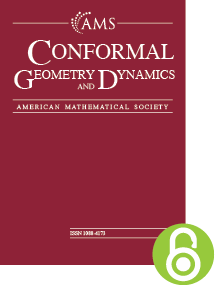Mating Kleinian groups isomorphic to $C_2\ast C_5$ with quadratic polynomials
HTML articles powered by AMS MathViewer
- by Marianne Freiberger
- Conform. Geom. Dyn. 7 (2003), 11-33
- DOI: https://doi.org/10.1090/S1088-4173-03-00087-0
- Published electronically: May 27, 2003
- PDF | Request permission
Abstract:
Given a quadratic polynomial $q:\hat {\mathbb {C}}\rightarrow \hat {\mathbb {C}}$ and a representation $G:\hat {\mathbb {C}} \rightarrow \hat {\mathbb {C}}$ of $C_2\ast C_5$ in $PSL(2,\mathbb {C})$ satisfying certain conditions, we will construct a $4:4$ holomorphic correspondence on the sphere (given by a polynomial relation $p(z,w)$) that mates the two actions: The sphere will be partitioned into two completely invariant sets $\Omega$ and $\Lambda$. The set $\Lambda$ consists of the disjoint union of two sets, $\Lambda _+$ and $\Lambda _-$, each of which is conformally homeomorphic to the filled Julia set of a degree 4 polynomial $P$. This filled Julia set contains infinitely many copies of the filled Julia set of $q$. Suitable restrictions of the correspondence are conformally conjugate to $P$ on each of $\Lambda _+$ and $\Lambda _-$. The set $\Lambda$ will not be connected, but it can be joined up using a family $\mathcal {C}$ of completely invariant curves. The action of the correspondence on the complement of $\Lambda \cup \mathcal {C}$ will then be conformally conjugate to the action of $G$ on a simply connected subset of its regular set.References
- Lars V. Ahlfors, Lectures on quasiconformal mappings, Van Nostrand Mathematical Studies, No. 10, D. Van Nostrand Co., Inc., Toronto, Ont.-New York-London, 1966. Manuscript prepared with the assistance of Clifford J. Earle, Jr. MR 0200442
- Alan F. Beardon, The geometry of discrete groups, Graduate Texts in Mathematics, vol. 91, Springer-Verlag, New York, 1983. MR 698777, DOI 10.1007/978-1-4612-1146-4
- Alan F. Beardon, Iteration of rational functions, Graduate Texts in Mathematics, vol. 132, Springer-Verlag, New York, 1991. Complex analytic dynamical systems. MR 1128089, DOI 10.1007/978-1-4612-4422-6
- S. R. Bullett and W. J. Harvey, Mating quadratic maps with Kleinian groups via quasiconformal surgery, Electron. Res. Announc. Amer. Math. Soc. 6 (2000), 21–30. MR 1751536, DOI 10.1090/S1079-6762-00-00076-7
- S. Bullett and C. Penrose, Regular and limit sets for holomorphic correspondences, Fund. Math. 167 (2001), no. 2, 111–171. MR 1816043, DOI 10.4064/fm167-2-2
- Shaun Bullett and Christopher Penrose, Mating quadratic maps with the modular group, Invent. Math. 115 (1994), no. 3, 483–511. MR 1262941, DOI 10.1007/BF01231770
- Robert L. Devaney (ed.), Complex dynamical systems, Proceedings of Symposia in Applied Mathematics, vol. 49, American Mathematical Society, Providence, RI, 1994. The mathematics behind the Mandelbrot and Julia sets; Lecture notes prepared for the short course held at the Annual Meeting of the American Mathematical Society, Cincinnati, Ohio, January 10–11, 1994; AMS Short Course Lecture Notes. MR 1315531, DOI 10.1090/psapm/049
- Adrien Douady and John Hamal Hubbard, On the dynamics of polynomial-like mappings, Ann. Sci. École Norm. Sup. (4) 18 (1985), no. 2, 287–343. MR 816367, DOI 10.24033/asens.1491 me Marianne Freiberger, Matings between Hecke Groups and polynomials, PhD thesis, Queen Mary, University of London, 2001.
- Bernard Maskit, Kleinian groups, Grundlehren der mathematischen Wissenschaften [Fundamental Principles of Mathematical Sciences], vol. 287, Springer-Verlag, Berlin, 1988. MR 959135 sm S. Bullett and M. Freiberger, Holomorphic correspondences mating quadratic maps with Hecke groups, preprint, 2002.
Bibliographic Information
- Marianne Freiberger
- Affiliation: School of Mathematical Sciences, Queen Mary, University of London, London E1 4NS, UK
- Email: M.Freiberger@qmul.ac.uk
- Received by editor(s): November 23, 2001
- Received by editor(s) in revised form: March 13, 2003
- Published electronically: May 27, 2003
- Additional Notes: The author was supported in part by the European Commission and EPSRC. The author would like to thank Shaun Bullett for many enlightening conversations. Also, thanks to the referee for useful comments
- © Copyright 2003 American Mathematical Society
- Journal: Conform. Geom. Dyn. 7 (2003), 11-33
- MSC (2000): Primary 37F45, 37F30, 37F05; Secondary 37F10
- DOI: https://doi.org/10.1090/S1088-4173-03-00087-0
- MathSciNet review: 1992035


